Overview
This article delves into the eating behaviors of autistic individuals, providing valuable guidance for parents as they navigate the unique challenges that autism presents in mealtime situations. It emphasizes that these eating behaviors are often shaped by sensory sensitivities, rigid routines, and communication difficulties. By understanding these influences, parents can create a supportive mealtime environment that fosters healthier dietary habits in their children.
As you read, consider how each child’s experience is unique. The challenges faced can feel overwhelming, but you're not alone. Many parents share similar stories, and together we can explore strategies that make mealtimes more enjoyable and less stressful.
We encourage you to reflect on your own experiences and think about how small changes can lead to positive outcomes. Let’s work together to create a nurturing atmosphere that promotes healthy eating habits and emotional well-being. Your journey toward understanding your child’s needs is a vital step in this process.
Introduction
Navigating the complexities of eating behaviors in autistic individuals unveils a landscape filled with unique challenges and profound insights. Research shows that children on the autism spectrum encounter eating problems at a rate significantly higher than their neurotypical peers. Understanding the underlying factors—such as sensory sensitivities, rigid routines, and emotional processing difficulties—is essential for parents seeking to support their children. This exploration not only illuminates the common eating challenges faced by these individuals but also underscores the importance of tailored strategies that can encourage healthier eating habits.
By creating supportive mealtime environments and collaborating with professionals, parents can empower their children to overcome barriers and embrace a more diverse and nutritious diet. Imagine transforming mealtime into a positive experience, where your child feels safe and encouraged to try new foods. Together, we can foster a nurturing atmosphere that promotes exploration and growth, ultimately leading to healthier choices and a happier relationship with food.
The Connection Between Autism and Eating Behaviors
Eating behaviors in autistic individuals, often referred to as autism eating, are influenced by a variety of factors, including sensory sensitivities, rigid routines, and communication challenges. Research indicates that children with autism spectrum disorder (ASD) experience autism eating issues at a rate five times higher than their neurotypical peers. This prevalence of selective eating can manifest as a strong preference for specific textures or flavors, while other items may be outright rejected.
Such behaviors are frequently linked to unique sensory processing issues in autism eating, where certain foods may feel overwhelming or unappealing. For instance, a child might refuse to eat vegetables due to their texture, which may be perceived as unpleasant. Understanding these patterns is crucial for parents, as it allows for a more empathetic approach to mealtime. By tailoring strategies to accommodate these sensory sensitivities, parents can create a more positive mealtime environment.
Recent studies highlight the impact of alexithymia—a common trait in autism characterized by difficulty in identifying and describing emotions—on dietary behaviors. This condition can hinder an individual's ability to understand their emotional and physical states, potentially leading to disordered dietary habits. Addressing alexithymia within therapeutic settings has shown promise in improving outcomes for autistic individuals facing challenges with food intake related to autism eating by enhancing emotional awareness and coping strategies.
Experts emphasize the importance of adapting mealtime routines to support the developmental and social needs of those engaged in autism eating. As Daniela Lopes Gomes from the Nucleus of Behavior Theory Research at the Federal University of Pará observes, "Adapting specialist mental health programs to the unique needs of young individuals is essential for fostering healthier dietary habits." By nurturing an inclusive and supportive environment, parents can assist their offspring in navigating the complexities of food, ultimately encouraging healthier habits and enhanced overall well-being.
Common Eating Challenges in Autism
Common dietary challenges in autistic individuals encompass a variety of behaviors that can significantly impact their nutritional intake and overall well-being.
- Selective Consumption: Many autistic children experience selective consumption, often gravitating towards a limited range of familiar foods. This prevalent issue raises concerns, as research indicates that binge consumption patterns among these selective eaters can lead to increased energy intake from ultra-processed items, ultimately affecting their diet quality. Notably, the fussiness subscale of the Child Consumption Behavior Questionnaire (CEBQ) includes 6 items that reflect the degree of these selective dietary behaviors, shedding light on the challenges faced.
- Aversions to Specific Items: Intense dislikes for certain foods may lead to nutritional deficiencies, particularly in essential vitamins and minerals. A review of the existing literature on nutritional adequacy in individuals with autism reveals mixed findings; while some studies indicate adequate nutrient intake, others highlight significant deficiencies. This underscores the importance of personalized evaluations to identify potential nutritional risks, especially considering the contradictory findings related to nutrient consumption in children with autism.
- Ritualistic Eating: Many children develop strict routines around meals, often insisting on specific items or following a particular eating sequence. This behavior can complicate mealtime dynamics and limit dietary variety, making it challenging for families to navigate.
- Sensory Sensitivities: Sensory issues are common, with textures, smells, and colors of food often overwhelming for those on the autism spectrum. For instance, as expert Stephen Shore notes, certain meal combinations can be intolerable due to differing textures, leading to a complete refusal to eat.
Understanding these challenges equips parents with the insight needed to approach mealtime with tailored strategies that address their child's unique needs. By fostering a supportive atmosphere and gradually introducing new foods, parents can help their children navigate these dining challenges more effectively. This journey can be daunting, but with patience and understanding, families can create a more enjoyable and inclusive mealtime experience.
Sensory Sensitivities and Their Impact on Eating
Sensory sensitivities significantly influence the eating habits of individuals with autism, often leading to unique preferences and aversions. Understanding these sensitivities is crucial for parents, as they can manifest in various ways:
- Taste Sensitivity: Many children may favor sweet or salty flavors, often turning away from bitter or sour tastes. This tendency can limit their dietary variety, making it essential for parents to recognize these inclinations.
- Texture Sensitivity: The texture of foods can be a significant barrier for some children. Items like fruits and vegetables may be intolerable due to their textures, leading to outright refusal. This sensitivity can hinder nutritional intake and create challenges during mealtimes.
- Visual Sensitivity: The visual appeal of dishes also impacts acceptance. Brightly colored or oddly shaped items may be rejected based solely on their appearance, complicating dietary choices further.
Research shows that sensory sensitivities are not only common but may also share genetic factors with conditions like anxiety and ADHD. A longitudinal study involving 25,627 autistic individuals revealed that sensory symptoms, including those affecting eating behaviors, tend to emerge early and persist throughout development. This highlights the importance of addressing these sensitivities in dietary planning, especially in the context of autism eating.
To support their children, parents can implement methods that promote gradual introductions to new dishes. Presenting new items in a non-threatening manner allows young ones to explore various textures and tastes at their own pace, fostering a more positive relationship with meals. As one instructor noted, "the displays are neat, tidy and uniformed," emphasizing the importance of structured and appealing presentations in encouraging acceptance.
Additionally, recent discussions underscore the necessity of incorporating sensory processing considerations into the Autism and Education strategy, which can enhance learning experiences and dietary planning for individuals with autism. Occupational therapists emphasize the significance of patience and creativity in this process, suggesting that making meals enjoyable and engaging can help ease the transition to a more varied diet.
By understanding and accommodating these sensory sensitivities, parents can play a pivotal role in enhancing their children's overall nutritional health and autism eating experience.
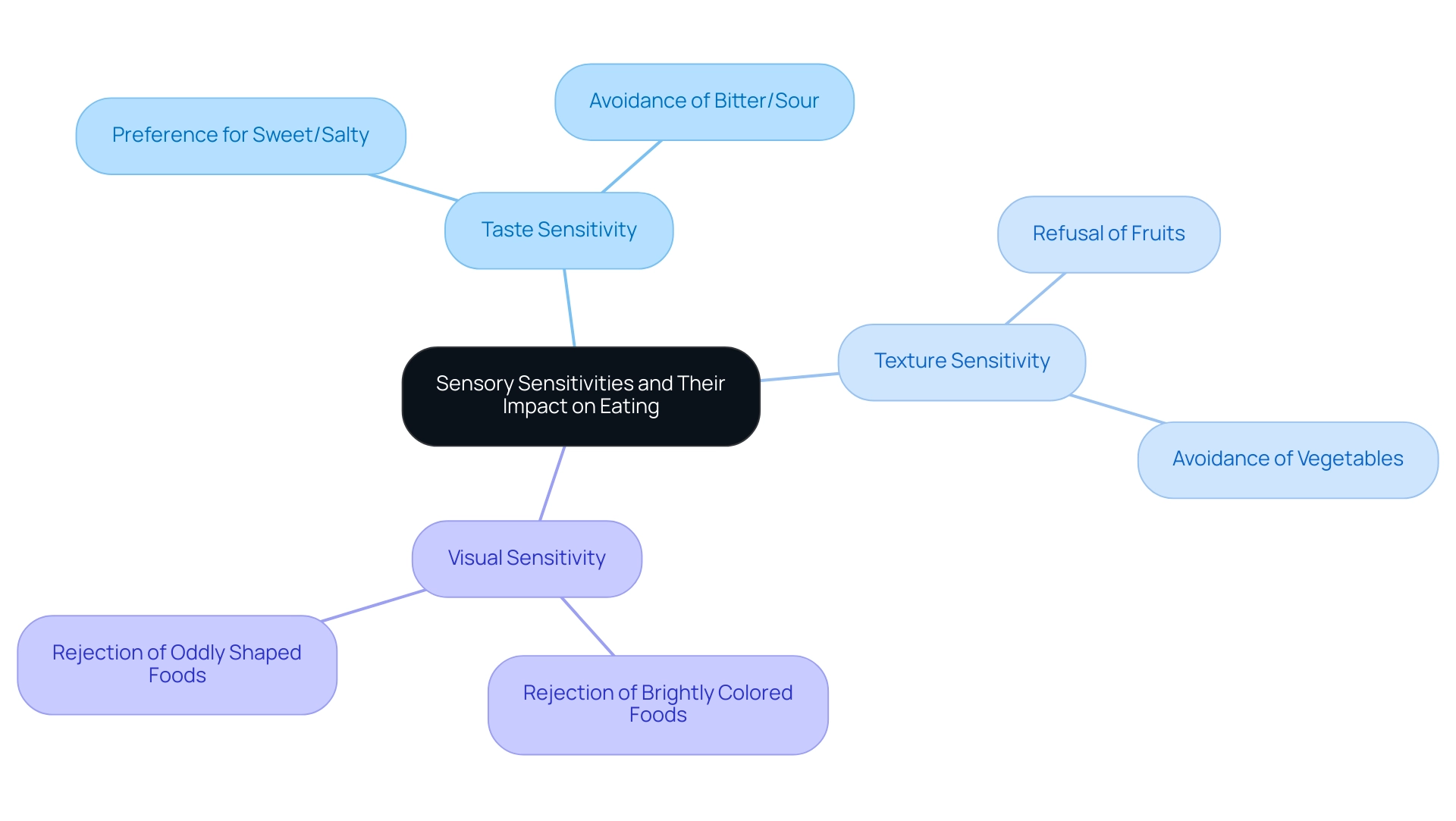
Strategies for Encouraging Diverse Food Choices
To encourage varied dietary options in autistic individuals, parents can implement several effective strategies that nurture their child's experience with food.
- Gradual Exposure: Begin by introducing new items alongside familiar favorites. This gentle method can alleviate anxiety and has proven successful. For instance, a case study highlighted a young individual who expanded their dietary repertoire from just four items to over 50 through a structured 12-step graduated exposure hierarchy over nine months. Initially, this young person faced significant challenges with meal selectivity, which limited their nutritional intake.
- Meal Play: Engaging youngsters in playful activities that involve meals—like cooking or creating art with edibles—can foster a positive association with food. This playful interaction often reduces resistance and increases their interest in trying new dishes.
- Visual Supports: Consider using charts or pictures to display various meal options. This approach makes the experience more engaging and less overwhelming. Visual aids can help children understand and anticipate new items, which can boost their eagerness to sample them.
- Positive Reinforcement: Celebrate and reward efforts to try new items, no matter how small these actions may seem. This encouragement can significantly enhance a young person's confidence and openness to exploring diverse flavors.
These strategies not only help children with autism become more comfortable with a variety of foods over time but also promote healthier dietary habits, addressing the common issue of food selectivity. The BAMBIC study indicates that individuals with feeding issues often display behaviors categorized into three subscales: Limited Variety, Food Refusal, and Disruptive Behavior. By directly observing dietary behaviors, caregivers can inform customized interventions, ensuring that every young person has the opportunity to develop healthier habits in a supportive environment.
As caregivers have noted, with the right strategies and support, every individual can cultivate healthier dietary habits in a nurturing environment. What strategies have you found helpful in your journey? Feel free to share your experiences in the comments or through our newsletter.
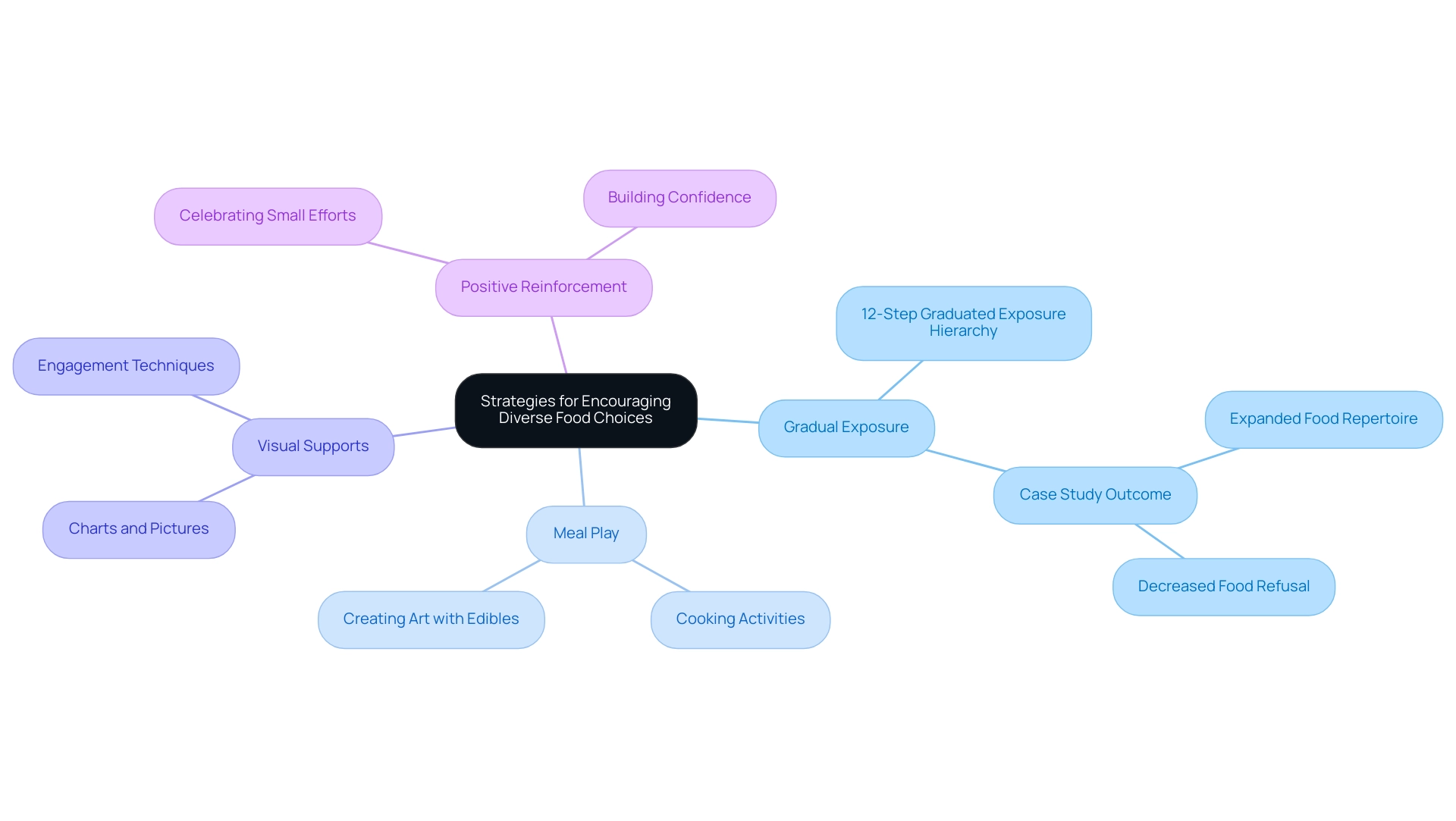
Creating a Supportive Mealtime Environment
Creating a supportive mealtime environment for children with autism is crucial for fostering positive eating habits and reducing challenges during mealtime. It’s important to understand that many families face unique struggles, and implementing key strategies can make a significant difference.
- Minimizing Distractions: Reducing noise and visual clutter is essential to help children focus on their meals. Research suggests that a calm environment can significantly enhance a young person's willingness to engage with food. Family therapists emphasize that minimizing distractions can lead to more successful dining experiences, especially for youngsters facing autism eating challenges due to sensory overload.
- Consistent Routines: Establishing regular meal times creates predictability, which is particularly beneficial for individuals with autism. Consistency in dining routines can help reduce anxiety and resistance to eating, making the experience more enjoyable for both the child and the family.
- Comfortable Seating: Ensuring that children are seated comfortably can enhance their sense of security during meals. A supportive seating arrangement can help them feel more at ease, encouraging them to participate in dining activities.
- Positive Interactions: Encouraging family conversations and positive interactions during meals can transform dining into a joyful occasion. Involving children in light-hearted discussions can distract them from any anxiety related to food, making them more open to trying new items.
Recent studies emphasize the importance of understanding the sensory preferences and environmental factors that affect participation during meals for children with autism. For example, a study titled "Future Research Directions on Mealtime Participation" identified gaps in knowledge regarding the experiences of autistic individuals and their families during meals. It suggests that future investigations should focus on collaborative studies with autistic individuals to better comprehend their needs and preferences, ultimately guiding the creation of effective supports for participation during meals.
Additionally, statistics reveal that 84% of individuals with autism have a co-occurring diagnosis, with 50% diagnosed with ADHD and 34% with anxiety. This prevalence underscores the additional challenges faced by autistic individuals during mealtimes. As Debbie, a concerned parent, shared, "Mealtime is often challenging and concludes in tears; [my child] waits until his meal goes cold and then objects when we ask him to eat it." This personal perspective highlights the emotional struggles families endure.
Moreover, problems with transitioning from smooth purées to textured foods and delays in drinking from a cup and self-feeding are common challenges for individuals, particularly in the context of autism eating. Future research should also explore the implications of behavioral profiles and cognitive impairments on feeding behaviors, emphasizing the complexity of these issues and the need for tailored strategies.
In summary, a structured and calm dining atmosphere—characterized by reduced distractions, consistent routines, comfortable seating, and positive interactions—can significantly enhance the eating experience for autistic individuals, paving the way for healthier dietary habits. Together, we can create a nurturing environment that supports our children during mealtimes.
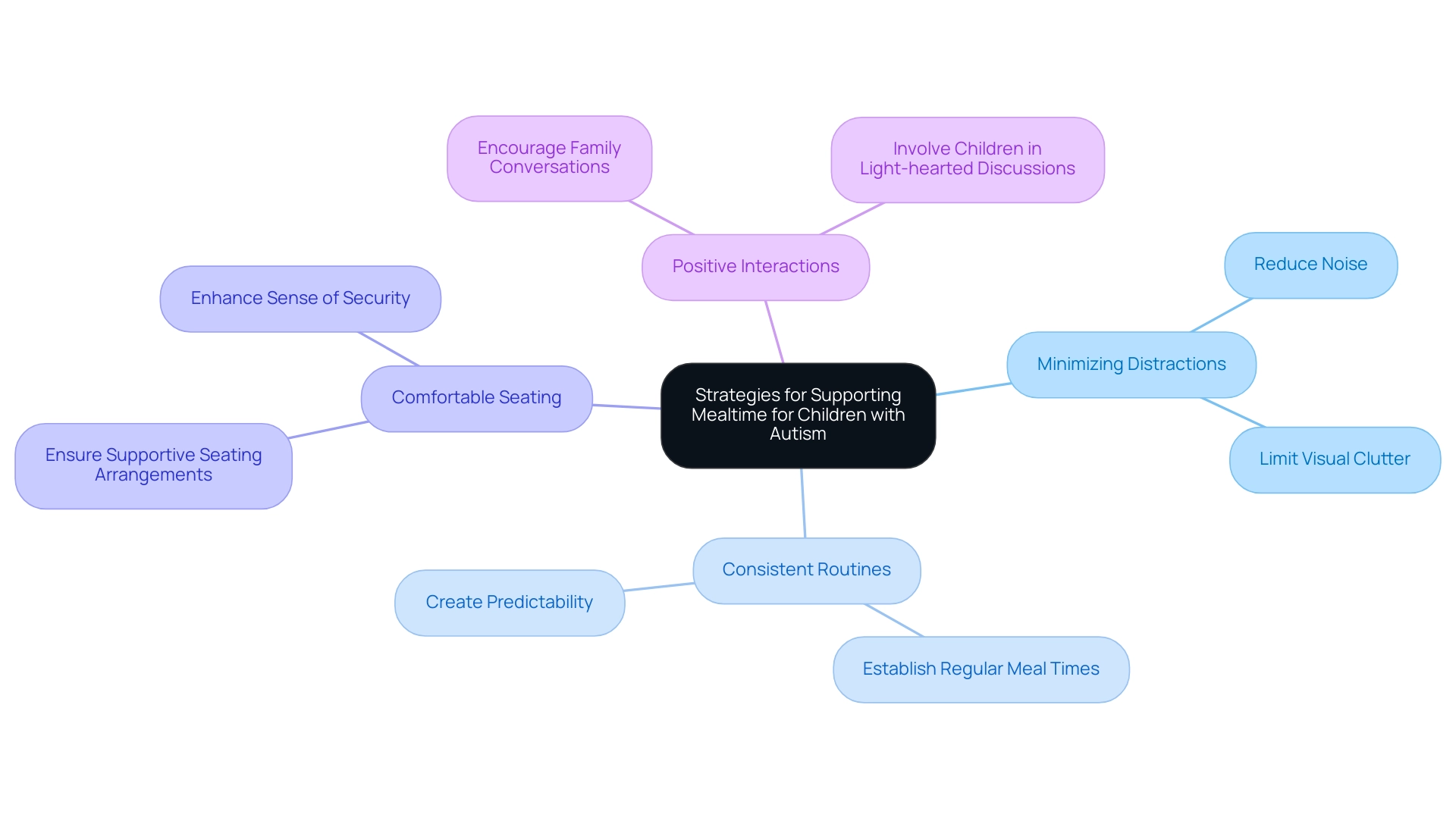
The Role of Routines in Eating Habits
Routines play a vital role in shaping the eating practices of autistic youths, providing a framework that can significantly enhance their dining experiences. Establishing a consistent mealtime routine can lead to several positive outcomes that every parent should consider:
- Reduce Anxiety: Predictable meal times create a comforting sense of security, allowing children to anticipate what comes next. This predictability is essential in alleviating stress and anxiety associated with eating times, as children often feel more at ease when they know what to expect.
- Encourage Acceptance: Regular exposure to dining routines fosters familiarity with various foods, helping young ones become more comfortable and open to trying new items. This gradual exposure is crucial for developing healthy eating habits.
- Facilitate Communication: Incorporating visual schedules into dining routines aids children in understanding the sequence of activities, from preparation to cleanup. This clarity not only enhances their engagement but also supports their ability to communicate effectively during meals.
Research shows that structured dining environments, which include clear expectations and visual supports, can significantly enhance engagement during meals for individuals on the autism spectrum. For example, a case study titled "Strategies for Positive Dining Experiences in Autism" underscores the importance of tailoring the dining environment to accommodate sensory sensitivities while offering choices to promote autonomy. By implementing strategies such as positive reinforcement—techniques that encourage desired dining behaviors—caregivers can effectively navigate challenges associated with autism eating, supporting children in establishing healthy eating habits.
Moreover, expert insights highlight that routines can play a pivotal role in reducing anxiety during meals. As noted by Karla K. Ausderau, Assistant Professor at the University of Wisconsin–Madison, "The results of this study aid in developing this understanding through the explanation of six distinct categories of parent strategies employed to enhance participation during meals in youngsters with ASD." This emphasizes the need for a nurturing environment that encourages participation.
Looking ahead, upcoming studies should explore family-focused methods to tackle dining challenges, stressing the importance of establishing a structured routine that encompasses preparation, consumption, and cleanup. By doing so, parents can reinforce positive behaviors and contribute to a more enjoyable mealtime experience for their children. Together, let’s create supportive dining environments that foster growth and comfort.
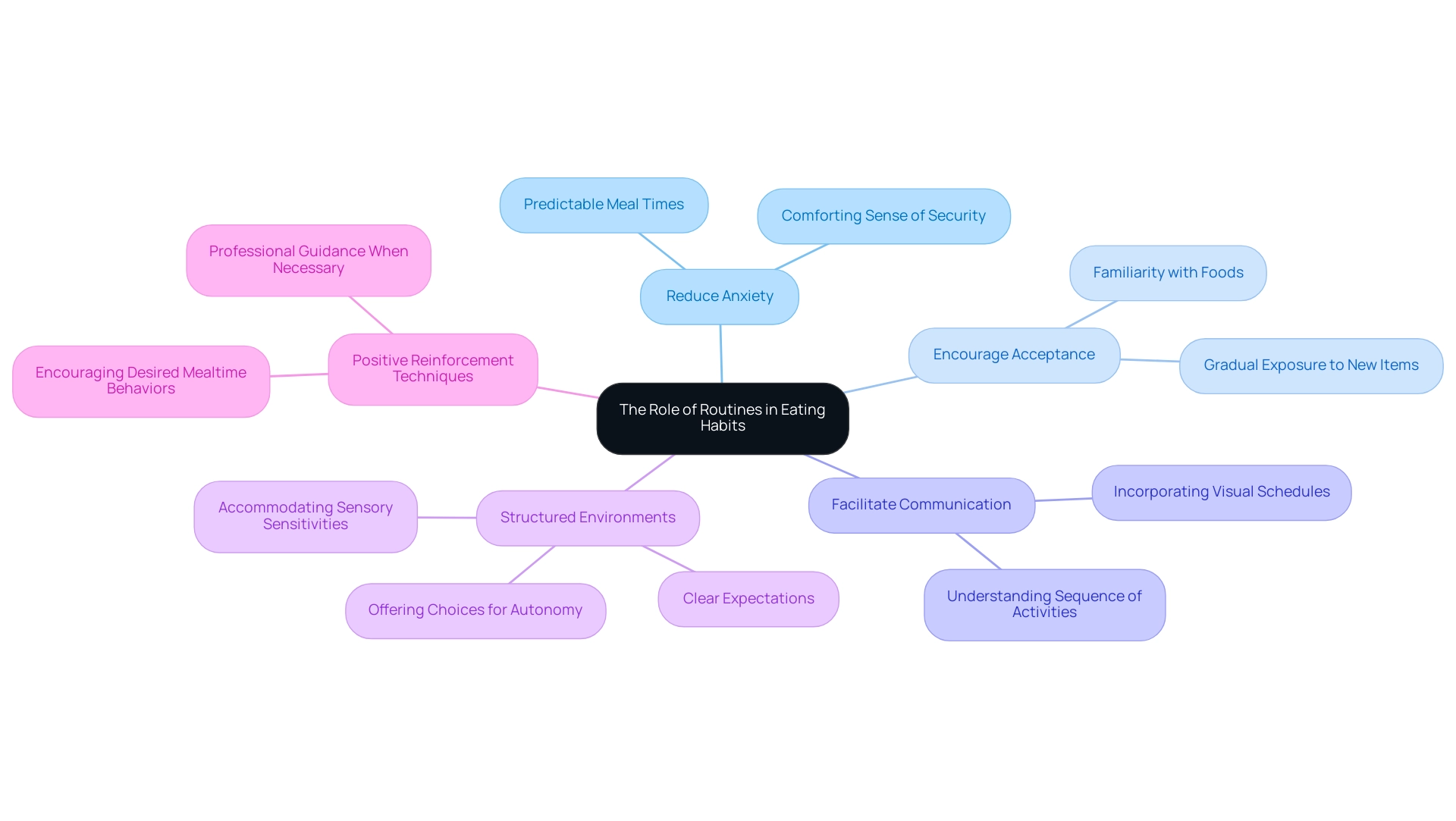
Understanding Eating Disorders in Autistic Individuals
Disorders related to food often co-occur with autism eating, a reality that can be intensified by sensory sensitivities and rigid consumption patterns. Among the most prevalent disorders are:
- Anorexia Nervosa: Marked by restrictive eating habits and an overwhelming fear of weight gain, this disorder can lead to severe weight loss and nutritional deficiencies.
- Bulimia Nervosa: Characterized by cycles of binge consumption followed by purging behaviors, this disorder can be particularly challenging for autistic individuals who may struggle with the emotional regulation needed to manage these cycles.
- Avoidant/Restrictive Food Intake Disorder (ARFID): Increasingly acknowledged in autistic populations, individuals may avoid certain foods due to sensory sensitivities or a lack of interest in eating. Notably, recent studies indicate that approximately 44% of children and young people diagnosed with ARFID also have an autism diagnosis, underscoring the need for tailored interventions.
As parents, it’s essential to remain vigilant for signs of these disorders. Look for significant weight loss, extreme food avoidance, or obsessive behaviors surrounding food. Seeking professional help is crucial, as early intervention can lead to better outcomes. Mental health specialists stress the importance of understanding the unique challenges faced by autistic individuals regarding eating disorders.
Marissa A Parsons notes, "Recognizing undiagnosed autism may benefit the patient, their family, and the clinical team to have a greater understanding of the individual and their treatment needs."
A recent study examining the correlation between autism traits and treatment duration found that individuals exhibiting a higher number of autism traits often require extended care for dietary disorders. This highlights the complexity of treatment and the necessity for specialized approaches tailored to the needs of individuals regarding autism eating. By fostering awareness and understanding, parents can better support their children in navigating these challenges.
ASD Media is committed to its six visionary and ambitious 2030 Goals, which aim to enhance the implementation of ABA therapy and improve outcomes for individuals with autism and ADHD.
Collaborating with Professionals for Effective Support
Working with experts such as dietitians, therapists, and pediatricians is crucial for enhancing support for children facing dietary challenges. Parents can take several proactive steps to navigate this journey:
- Seek Assessments: It is vital for parents to have their child evaluated for sensory processing issues or eating disorders. Early identification can lead to tailored interventions that address specific needs.
- Develop Meal Plans: Collaborating with dietitians allows parents to create balanced meal plans that meet their child's nutritional requirements while considering individual preferences. This personalized approach can significantly improve dietary adherence.
- Implement Behavioral Strategies: Engaging therapists to develop behavioral interventions can foster positive dietary habits. These strategies can help young individuals manage their preferences and reduce anxiety during mealtimes.
Research indicates that effective collaboration can lead to comprehensive support that addresses both behavioral and nutritional aspects of dietary challenges. For instance, a recent study highlighted the pandemic's impact on food insecurity among families with autistic children, underscoring the need for healthcare professionals to recognize and address the unique dietary difficulties associated with autism. Parents reported increased stress related to meal availability and selective consumption, emphasizing the importance of expert guidance.
As Mrs. Turner observed, "I believe it’s impacting Adam for sure … It’s definitely influencing Adam, Adam’s food, he consumes so well but because Justin isn’t partaking, then sometimes Adam doesn’t … I recall feeling like 'oh no Justin’s bad habits are rubbing off on Adam.'" This quote illustrates how peer influence can affect the eating habits of autistic youths.
Moreover, effective meal strategies developed with dietitians have proven to enhance the dining experiences of children with autism. Dietitians play a pivotal role in supporting these children by providing expert guidance on nutrition and adaptable meal options, which can lead to improved dietary habits. Recent findings recommend that healthcare professionals offer advice on nutrition and flexible food choices to foster better dietary practices.
In summary, the collaboration between parents and professionals is not merely beneficial but essential in overcoming the dietary challenges faced by autistic children. This partnership paves the way for healthier eating habits and improved overall well-being, encouraging parents to seek support and resources in this important endeavor.
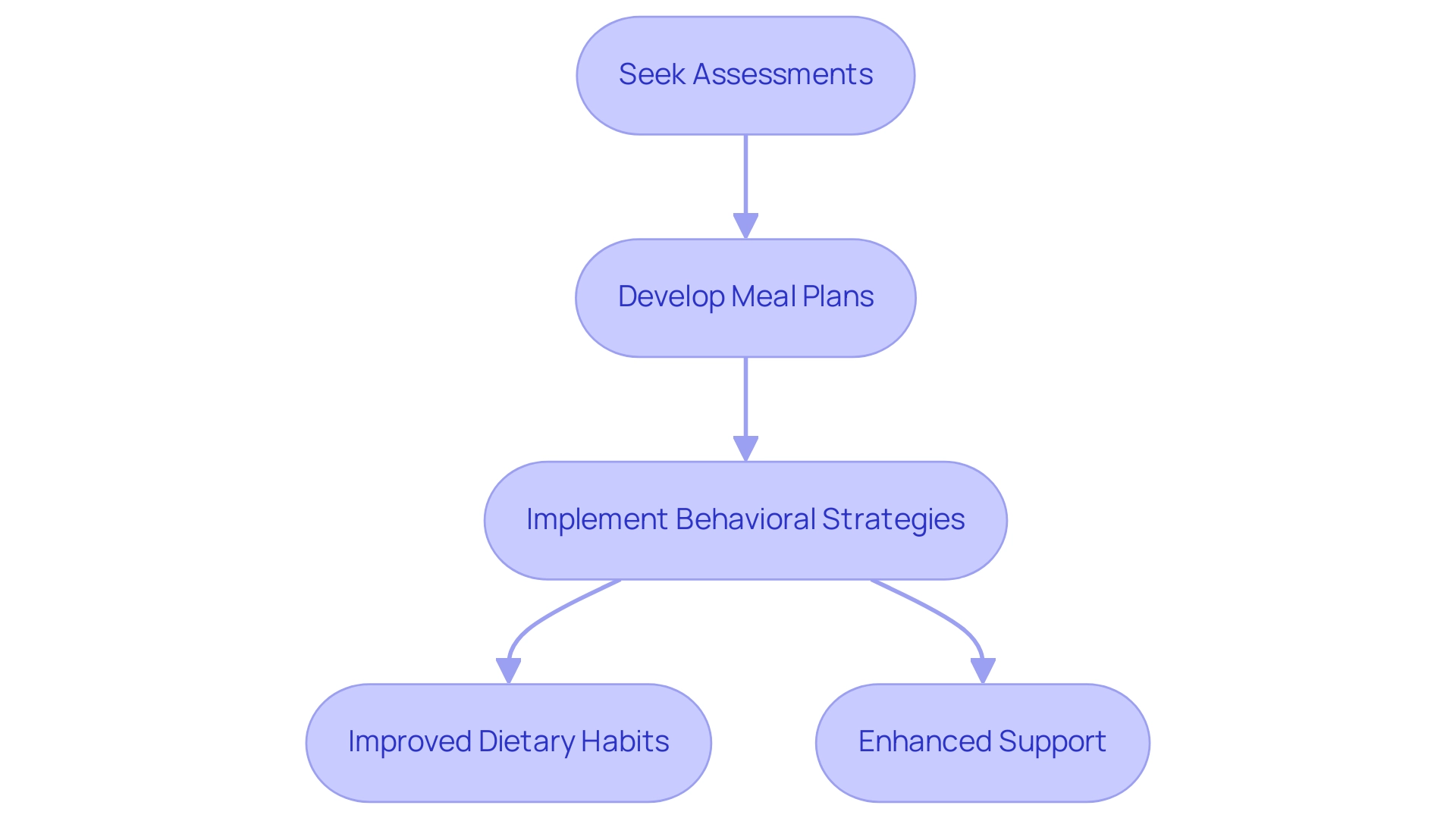
Conclusion
Navigating the eating behaviors of autistic individuals presents a complex yet vital challenge for parents and caregivers. The prevalence of eating difficulties among autistic children—stemming from sensory sensitivities, rigid routines, and emotional processing issues—calls for a comprehensive understanding of these factors. By recognizing unique challenges such as picky eating, food aversions, and the impact of routines, parents can adopt tailored strategies to foster a more positive mealtime experience.
Implementing gradual exposure to new foods, creating supportive environments, and collaborating with professionals like dietitians and therapists are essential steps in encouraging healthier eating habits. These strategies not only alleviate anxiety and resistance but also promote exploration and acceptance of diverse food choices. Structured mealtime routines, minimized distractions, and engaging interactions can transform meals into opportunities for growth and connection, ultimately leading to improved nutritional intake and overall well-being.
In summary, fostering a nurturing atmosphere where autistic children feel safe and supported in their eating journeys is crucial. By understanding their unique behaviors and challenges, parents can empower their children to embrace a more varied and nutritious diet, paving the way for a happier and healthier relationship with food. Together, through informed strategies and professional collaboration, the goal of promoting healthier eating habits can be achieved, enhancing the quality of life for autistic individuals and their families.
Frequently Asked Questions
What are the main factors influencing eating behaviors in autistic individuals?
Eating behaviors in autistic individuals are influenced by sensory sensitivities, rigid routines, and communication challenges.
How common are eating issues among children with autism spectrum disorder (ASD)?
Research indicates that children with ASD experience eating issues at a rate five times higher than their neurotypical peers.
What does selective eating in autistic children typically involve?
Selective eating can manifest as a strong preference for specific textures or flavors, while other foods may be outright rejected.
How do sensory processing issues affect eating behaviors in autistic individuals?
Certain foods may feel overwhelming or unappealing due to sensory processing issues, leading to refusals based on texture or other sensory attributes.
What role does alexithymia play in the dietary behaviors of autistic individuals?
Alexithymia, characterized by difficulty in identifying and describing emotions, can hinder an individual's understanding of their emotional and physical states, potentially leading to disordered dietary habits.
How can addressing alexithymia improve eating habits in autistic individuals?
Therapeutic interventions that address alexithymia can improve emotional awareness and coping strategies, which may enhance food intake and dietary behaviors.
What is the significance of adapting mealtime routines for autistic individuals?
Adapting mealtime routines supports the developmental and social needs of autistic individuals, fostering healthier dietary habits in a supportive environment.
What are some common dietary challenges faced by autistic individuals?
Common challenges include selective consumption, aversions to specific items, ritualistic eating, and sensory sensitivities.
How does selective consumption affect the diet quality of autistic children?
Selective consumption can lead to increased energy intake from ultra-processed items and raise concerns about nutritional adequacy.
What are the potential nutritional risks for autistic individuals due to their eating behaviors?
Intense dislikes for certain foods can lead to nutritional deficiencies in essential vitamins and minerals, highlighting the need for personalized evaluations.
How can parents support their autistic children during mealtime?
Parents can create a supportive atmosphere, gradually introduce new foods, and tailor strategies to address their child's unique needs to navigate dining challenges effectively.




